click on images to enlarge
A FORGOTTEN OBJECT: THE SILVER WARMER
When central heating was not available,
besides stove and fireplace, another heating item was used in ancient times:
the warmer (or brazier).
It was a container in metal, terracotta or ceramic
filled with embers and warm ash used as personal heating support and bed warming.
The female custom to hold the warmer next to the body or under the garment is at the origin
of the Dutch popular believing that women could be made pregnant simply holding the warmer
on their womb.
A similar believing was present also in Tuscany, but in this case the responsible was a
winged pretty airy fairy (folletto) who introduced itself in the body of the woman and she
was made pregnant (see endnote).
|
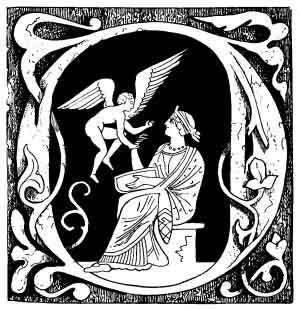 |
| |
a pretty airy fairy (folletto) makes pregnant the woman holding the warmer
|
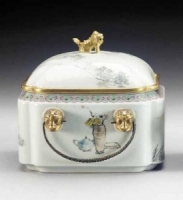 |
The warmers had a metal liner to avoid the direct contact of the
live coal with the external surface. The ceramic warmers were painted on the sides and on
the lid with rich floral decorations, scenes of daily life or landscapes..
|
|
'famille-rose' ceramic warmer
(19th century)
|
|
A particular item was the bed-warmer. It had a turned wood handle
and, in Italy, was used into an appropriate support to avoid damage to blankets.
|

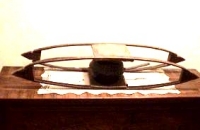
|
| |
Victorian bed-warmer with long wood handle and the support used in Italy to
protect the blankets
|
In Italy, the silver warmer was of oval or circular shape with pierced lid for a better
diffusion of the warmth (the holes were called 'sfiatatoi'), wood or metal feet, elaborate scroll handle
with a wood or ivory support on the centre.
The 18th and the 19th century production of silver warmers attained a high artistic level,
with models which followed step by step the taste and the stilistic evolution of their time (ornamentation
with flowers, leaves, masks, geometric bands, gadroons, beadworks ...).
This item was a typical artifact produced by the most renown silversmiths throughout Italy (Rome,
Naples, Florence, Milan) (see below).
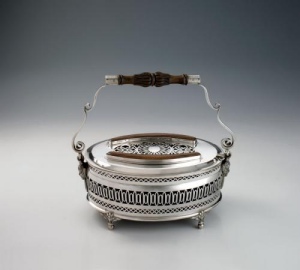 |
silver warmer of oval shape, standing on four ball and foliate
feet, pierced on the body and on the lid, scroll handle. Silversmith Alessandro Zanetti,
Bologna, end 18th - beginning 19th century
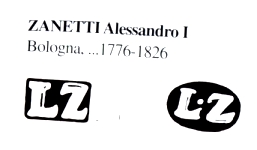 |
|
Silversmith Alessandro Zanetti, Bologna,
end 18th - beginning 19th century
|
|
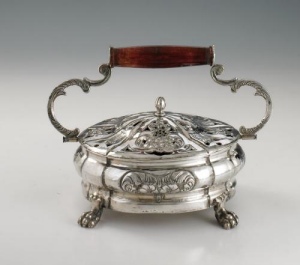 |
silver warmer of circular shape, standing on four paw feet,
gadrooned embossed body, pierced lid with floral motif, double scroll handle. Presumably
Naples, 1824/1832.
|
|
Presumably Neaples, 1824/1832
|
|
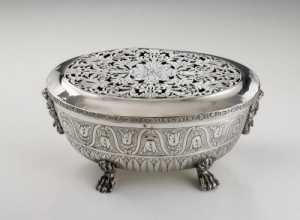 |
silver warmer of oval shape, standing on four paw feet, pierced
lid with floral motifs. Silversmith Giannotti Angelo, Rome, 1824-1865
 |
|
Silversmith Giannotti Angelo, Rome, 1824-1865
|
|
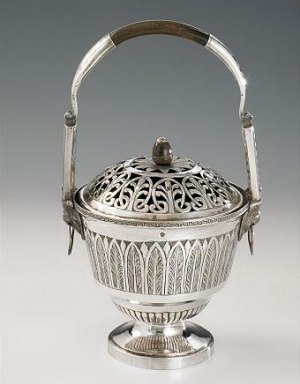 |
silver warmer of circular shape standing on a plain feet, body
gadrooned and with large floral band, pierced lid and bud finial.
Silversmith Menazzi Girolamo, Rome, 1802-1835
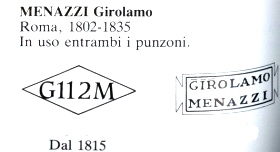 |
|
Silversmith Menazzi Girolamo, Rome, 1802-1835
|
|
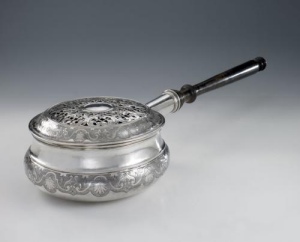 |
silver bed warmer of circular shape with ebonized turned wood handle, large
chiselled band on the body and on the lid.
Silversmith Biagio Giordano, Naples, 1774-1793
 |
|
Silversmith Biagio Giordano, Neaples, 1774-1793
|
|
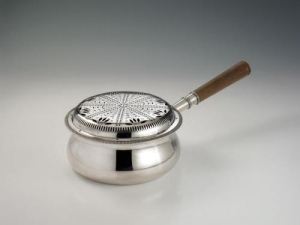 |
silver bed warmer of circular shape with turned wood handle.
Plain body and pierced lid. Milan about 1820
|
|
Milan about 1820
|
|
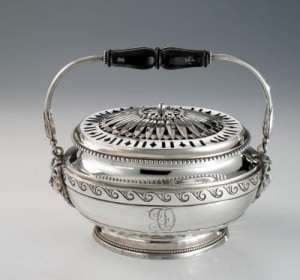 |
silver warmer of oval shape standing on oval beaded foot. Body
engraved with monogram FO and decorative motifs, pierced lid with leaves.
Silversmith Angelo Codacci, Florence, 1773-1821
 |
|
Silversmith Angelo Codacci, Florence, 1773-1821
|
|
(endnote) the tradition of women rendered pregnant by fire was well known in ancient Etruria and
is mentioned in Roman age by Plinius and Livius. They report that Ocresia (a prisoner of war of noble
origins) was rendered pregnant by the fire of the domestic Lares (household gods) generating in such way
Servius Tullius, who, after the death of his spouse's father Tarquinius Priscus (Tarquin the Elder), was
elected the sixth King of Rome.
an article for www.silvercollection.it - A Small Collection of Antique Silver and Objects of Vertu
|
|
